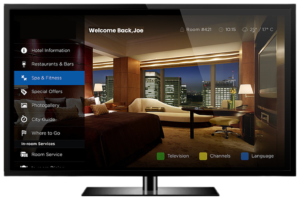Address
304 North Cardinal St.
Dorchester Center, MA 02124
Work Hours
Monday to Friday: 7AM - 7PM
Weekend: 10AM - 5PM

Simply simply, OTT advertising is a type of digital advertising that uses OTT platforms. Over-the-top advertising allows your business to directly target people via streaming devices and services. It allows you to target a certain market group or audience using OTT platforms.
OTT advertising offers an exciting opportunity to boost client interaction across many platforms while increasing your advertising ROI.
In recent years, the number of people using OTT platforms has increased dramatically. As people flock to OTT services to discover new content, the number of active users on these platforms has surpassed the US population.
“By 2024, it’s anticipated that streaming platforms will have gathered 210 million users, representing a startling amount of customers and a dramatic shift in media habits,” according to Nielsen.
OTT advertising has surpassed traditional TV advertising as millions continue to shift away from traditional Pay-TV operators. As more people flock to freshly established OTT channels, it is critical that you include OTT advertising into your digital marketing strategy to more effectively target a specialised demographic and reduce ad spend waste.
By curating content, OTT platforms use analytics and, in some cases, artificial intelligence to enable enhanced audience targeting and greater monetization.
A bigger quantity of adverts does not always imply a better revenue. To effectively monetize, you must target the correct group of clients. OTT channels may identify consumers who are more likely to click on your adverts for a product or service, increasing brand recognition and generating greater conversions through better segmentation (and more categories to analyze).
Unlike TV advertisements, OTT advertising intersperses adverts in the correct places and for short periods of time between movies and shows, which viewers are considerably more likely to watch. Consumers can engage more effectively with the advertising, and you can even direct them to your product and service pages if they click on the relevant links.
Shorter, more interesting advertising can sometimes increase ad recall. According to a Global Advertising Research Center research, 30-second ads are perfect for a solid brand-building television advertisement since they provide enough time to develop an emotional and intellectual connection without losing interest.
According to several research, brief commercials generate almost as much interest as longer ones. According to a research published in the Journal of Advertising Research, 7-second adverts were almost as successful as 15-second advertisements and 60% as effective as 30-second advertisements.
Because you do not pay for ad’real-estate’ on print media or outdoor digital signages, OTT advertising helps you to decrease ad expenditure. You also don’t spend time and money targeting the wrong people with limited TV ad windows.
By measuring crucial indicators, OTT advertising enables for a more particular and targeted advertising strategy, allowing you to better evaluate the relative effectiveness of your advertising campaigns. These data enable you to better understand audience preferences, allowing you to simplify ad expenditure and reallocate resources as needed.
Viewers are progressively abandoning traditional broadcast TV networks in favour of OTT channels delivered via mobile devices over the internet. People are no longer restricted to a single device or place to discover and consume content. Hence, OTT platforms reduce the limitations of broadcast entertainment services that rely on cables and wires.
OTT platforms’ extensive user analytics allow you to target consumers based on their location and device choices. You may then tailor your advertising approach to those characteristics for improved outcomes and lower ad spend.
Conventional watching experiences can be disrupted by unanticipated occurrences like as network failures, signal problems, and power outages, particularly in underdeveloped nations. Strict TV schedules that broadcast programmes at specific times of day limit viewers’ ability to access programming at any time. OTT platforms, on the other hand, provide greater accessibility and interaction, resulting in continuous ad serving.
There are several OTT channels/platforms that provide OTT advertising for your product and business from which to pick. So how can you know which ones would do a better job for your unique advertising requirements? How can you cross off your set of business KPIs by providing advertising in terms of conversion likelihood, simplicity of operation, resource availability, and more?
The most notable advantage of Amazon’s OTT advertising, known as Amazon Fire Advertising, is that it attracts customers from all over the world. You can never go wrong with Amazon advertisements because they have achieved huge success with their broad video streaming device and platform offering. They are also one of the few OTT ad technology that has support from numerous first-party and third-party applications, allowing for greater widespread campaign success. Advertisers may now buy more ad space on Amazon’s IMDb TV.
Roku is the closest competitor to Amazon Fire TV. Roku began as a CTV (Connected TV) experience device and has since expanded to streaming services via its OTT platform, The Roku Channel.
The entirely ad-based strategy provides marketers with a wide range of advertising options. Most Roku users also do not subscribe to a supplementary OTT channel, making them an exclusive pool in terms of ad viewership.
Hulu is one of the most established and widely used OTT platforms. They provide a number of subscription options for customers, allowing marketers to target different user segments.
Hulu’s ad manager provides adjustable pricing options for various enterprises. It is now available to SMEs, as opposed to their previous pricy alternative, and marketers may target customers who choose ad-based subscriptions due to pricing differences. Hulu is unique in that it broadcasts TV episodes and movies before they are available on cable or in theatres.
To deliver more tailored adverts to consumers, Sling has merged traditional cable TV advertising with current digital tactics. These advertisements cannot be skipped, and advertisers pay for impressions. They also employ programmatic advertising, which gives businesses more control over where and how their TV inventory is advertised. Sling TV is an excellent solution for businesses looking to maximise ad expenditure while also providing data-driven sophisticated targeting possibilities.
Tubi is a one-of-a-kind OTT platform that is the number one channel in what they do. Tubi offers both live streaming and normal broadcast TV commercials, and it has 33 million active users as of 2021. Tubi’s live streaming and planned TV streaming enable advertising to run uninterrupted. This OTT network is not going away anytime soon, thanks to its extensive collection of TV episodes and movies aimed towards a younger demographic.
In your search for the top OTT advertising platforms, you may come across terminology like AVOD, CTV, and Linear TV. It is critical to understand the distinction between these in order to guarantee that your advertising goals are on track. Let’s get started!
AVOD does not market premium content to its customers as much as other OTT advertising providers do. Marketers should focus on AVOD if their product can be consumed by a broader pool of people at a lesser cost. Consumers prefer device independence while watching content, which allows advertisers to target them with customised adverts.
Linear TV is the standard television viewing experience that includes scheduled programming. The sole improvement in today’s OTT channels is that consumers may now watch linear TV on a variety of mobile devices. Linear TV viewership has been progressively dropping in recent years.
Linear TV, CTV, and Addressable TV (TV linked to the internet for on-demand programming) are all examples of advanced TV. Consumers prefer device independence while watching content, which allows advertisers to target them with customised adverts.
In the OTT advertising sector, advertisers have several possibilities. Sometimes you have to select between a consistent level of ad investment and paying based on the various ad expenditure methods outlined below. You should carefully analyse each of these options based on how much money you want to spend and how long you want your adverts to be visible for.
CPCV (cost per completed view): As an advertiser, you are only obligated to pay for ads that have been aired to the end without users picking the’skip ad’ option. If there is no opportunity to skip, some OTT streaming strategies result in higher engagement.
The cost of an advertisement is measured using vCPM (viewable cost per mille) or vCPV (viewable cost per view). This option is ideal for marketers that want to achieve a high number of ad impressions throughout their campaign period.
CPH and CPS are for individuals who wish to pay based on the number of impressions produced by their ad.
CPE may also be used to calculate the value of advertisements based on the amount of interaction they produce.
To get started in the OTT advertising arena, you’ll need to understand the various OTT platforms and the advertising inventory they provide. You may build and implement an advertising plan based on your marketing objectives, budget, and other factors such as your target audience pool.
There are essentially two alternatives to consider:
After you’ve decided how to market, you may design your advertisements with proper text, duration, and placement in mind. Finally, it is critical to assess the effectiveness of your advertisement and the outcomes of your marketing effort.
To summarise, OTT advertising is more than simply a passing fad in today’s entertainment industry. It is an effective marketing channel. It is less expensive than traditional advertising and television because it can target the correct customers through greater segmentation – if you know your customer, you can confidently invest your marketing money.
There are several advertising services/platforms available, some large and others tiny. You must pick where your marketing expenditures should be spent. Bigger service providers, such as Amazon, would have a wider consumer base, but smaller, maybe specialist services may allow you to target certain market groups that are better aligned with your marketing aims.
There is no time better than right now to embrace OTT advertising – low competition (for now) and better segmentation means lower costs – and more customers!





























































































